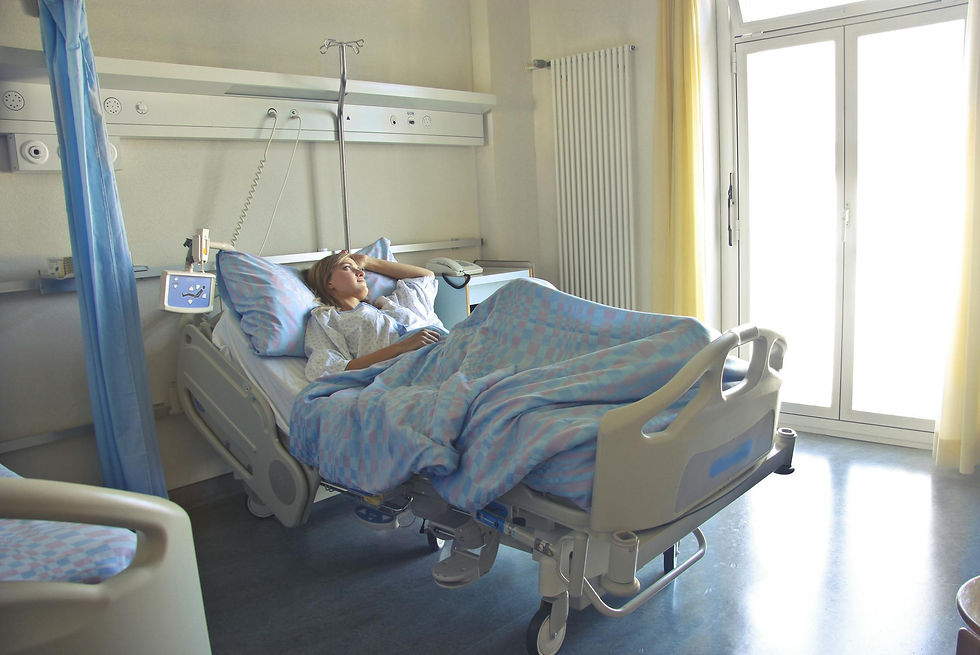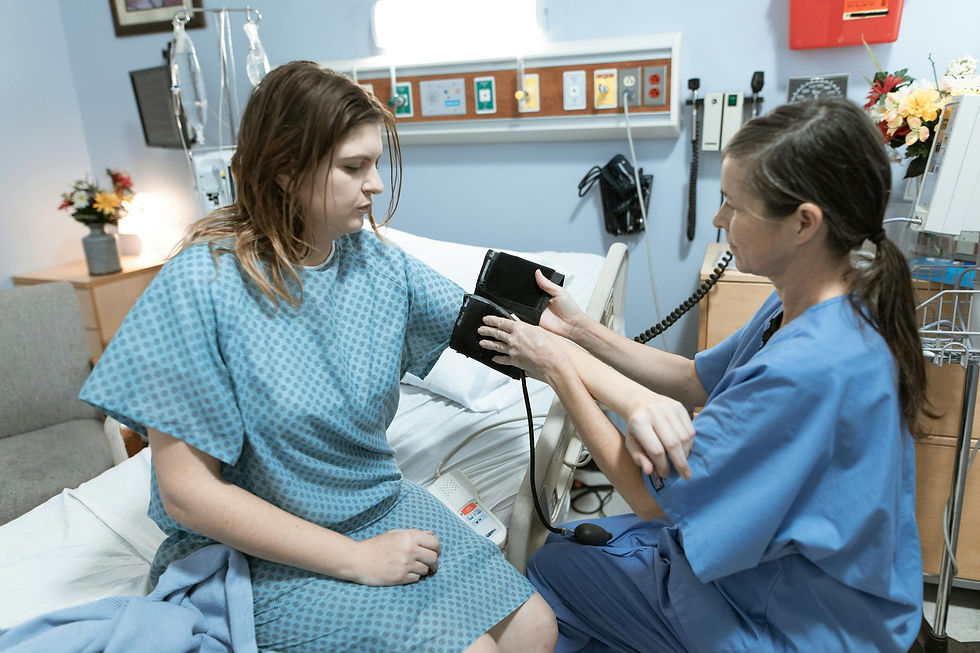What are the warning signs and symptoms of Sepsis?
- Mohammed A Rashad
- May 7, 2024
- 6 min read
Updated: Oct 8, 2024

Did you know that sepsis claims more lives each year than breast, bowel, and prostate cancer combined? This staggering statistic highlights the critical importance of recognising sepsis early. Sepsis, a life-threatening response to infection, can escalate quickly, leading to tissue damage, organ failure, and even death if not treated promptly.
Understanding the warning signs and symptoms of sepsis can be the difference between life and death. This guide discusses the key indicators you need to be aware of, helping you act swiftly to seek medical attention. Whether you're a healthcare professional or someone wanting to protect your loved ones, knowing these symptoms can empower you to make crucial decisions in this medical emergency.
Key Takeaways
What is Sepsis?
Sepsis is a serious medical condition that occurs when the body's response to an infection causes widespread inflammation. This inflammation can lead to a cascade of changes that damage multiple organ systems, potentially causing them to fail. Sepsis can result from any type of infection, including bacterial, viral, or fungal infections.
It is a life-threatening emergency that requires immediate medical attention. Early diagnosis and treatment are crucial to improve outcomes and reduce the risk of severe complications.
What are the Early Warning Signs of Sepsis?
Recognising the early warning signs of sepsis is essential for timely intervention. The initial symptoms can be subtle and easily mistaken for other illnesses, but their rapid progression can quickly become life-threatening. Key early warning signs include:
Fever and Chills: A high temperature, often accompanied by chills, is a common initial sign.
Rapid Breathing and Heart Rate: An increased breathing rate and a faster heartbeat are early indicators.
Confusion or Disorientation: Changes in mental status, such as confusion or difficulty concentrating, can be early signs of sepsis.
Extreme Discomfort or Pain: Severe discomfort or pain, sometimes described as the worst pain ever, is another warning sign.
Sweaty or Clammy Skin: Unusually sweaty or clammy skin can also be an early indicator of sepsis.
Causes of Sepsis
Bacterial Infections
What is the most common cause of sepsis? Bacterial infections. These infections can originate in various body parts, such as the lungs (pneumonia), urinary tract, abdomen, or skin. Bacteria entering the bloodstream can trigger a severe immune response, leading to widespread inflammation and tissue damage.
Viral Infections
Viral infections, such as influenza or COVID-19, can also lead to sepsis, although they are less common causes compared to bacterial infections. When a viral infection becomes severe, it can provoke a strong immune response that results in the symptoms of sepsis.
Fungal Infections
Fungal infections, particularly in individuals with weakened immune systems, can cause sepsis. These infections are often opportunistic, taking advantage of the body’s reduced ability to fight off pathogens.
Other Potential Causes
Sepsis can also result from other sources, such as parasitic infections or secondary infections following surgery or injury. In some cases, the exact source of the infection may not be identified, but the inflammatory response still leads to sepsis.
How Sepsis Develops
Sepsis develops when the body’s response to an infection becomes dysregulated, leading to widespread inflammation. This inflammation can cause blood clots and leaky blood vessels, impairing blood flow and depriving organs of nutrients and oxygen.
Explanation of the Body's Response to Infection
When an infection occurs, the body’s immune system releases chemicals into the bloodstream to combat the invading pathogens. In sepsis, this response becomes exaggerated, causing extensive inflammation.
Warning Signs of Sepsis in Children
Recognising sepsis in children can be particularly challenging as symptoms may differ from those in adults. Early identification is crucial to ensure prompt treatment.
Fever or Low Body Temperature
Lethargy or Irritability:
Unusual Sleepiness
lack of Interest in Activities
Difficulty Breathing
Poor Feeding or Vomiting
Mottled or Pale Skin
Rash
Warning Signs of Sepsis in Adults

Adults with sepsis may exhibit a range of symptoms, some of which are similar to those seen in children but may be more easily recognisable due to their ability to communicate discomfort.
Fever and Chills
Rapid Breathing and Heart Rate
Confusion or Disorientation
Extreme Pain or Discomfort
Clammy or Sweaty Skin
Shortness of Breath
Diagnosis of Sepsis
Medical Evaluation
Diagnosing sepsis involves a comprehensive medical evaluation to identify the presence and source of infection, as well as the extent of the body's response.
Physical Examination
The first step in diagnosing sepsis is a thorough physical examination. Healthcare providers will check for signs of infection and organ dysfunction, such as abnormal vital signs, skin changes, and altered mental status.
Laboratory Tests (Blood Tests, Cultures)
Laboratory tests are crucial in diagnosing sepsis. Blood tests can reveal abnormalities in white blood cell count, platelet count, and other markers of infection and inflammation. Blood cultures help identify the specific pathogen causing the infection, guiding appropriate antibiotic therapy.
Imaging Studies (X-rays, CT Scans)
Imaging studies, such as X-rays and CT scans, are used to locate the source of infection within the body. These tests can identify pneumonia, abscesses, or other infections contributing to sepsis.
Treatment of Sepsis
Immediate Interventions
Prompt treatment is essential in managing sepsis. Early intervention can prevent the condition from progressing to severe sepsis or septic shock.
Administration of Antibiotics
Broad-spectrum antibiotics are administered as soon as sepsis is suspected. These antibiotics are chosen to cover a wide range of potential bacteria until specific pathogens are identified through cultures.
Intravenous (IV) Fluids
Intravenous (IV) fluids are given to maintain blood pressure and ensure adequate blood flow to vital organs. Fluid resuscitation is a critical component of initial sepsis management.
Ongoing Medical Care
Once immediate interventions are in place, ongoing medical care focuses on monitoring and supporting the patient’s recovery.
Monitoring Vital Signs
Continuous monitoring of vital signs, such as heart rate, blood pressure, respiratory rate, and oxygen levels, is essential to track the patient’s progress and adjust treatment as needed.
Supportive Care (e.g., Oxygen, Dialysis)
Supportive care may include oxygen therapy to ensure sufficient oxygen levels in the blood and dialysis to support kidney function if the kidneys are affected by sepsis.
Medications to Stabilize Blood Pressure
Medications, such as vasopressors, may be required to stabilize blood pressure if it remains low despite fluid resuscitation. These medications help maintain adequate blood flow to the organs.
Conclusion
Recognising and understanding the warning signs and symptoms of sepsis is crucial for early intervention and effective treatment. Sepsis is a life-threatening condition that requires immediate medical attention to prevent severe complications and improve survival rates.
By familiarising yourself with the causes, symptoms, and preventative measures, you can play a vital role in protecting your health and the health of your loved ones. Stay informed, stay vigilant, and seek prompt medical care if you suspect sepsis. Early action can save lives.
FAQs
What are the first warning signs of sepsis?
The first warning signs of sepsis often include a high fever and chills, rapid breathing, heart rate, and confusion or disorientation. Early recognition of these symptoms is crucial for prompt medical intervention.
What are three red flags for Sepsis?
What is a key indicator of Sepsis?
How does Sepsis start?
How long does it take to die from Sepsis?

Comments